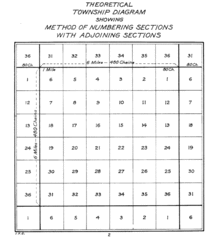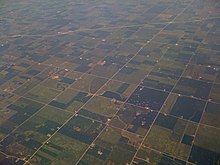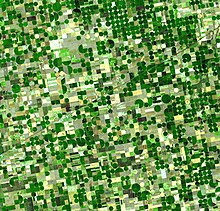


In U.S. land surveying under the Public Land Survey System (PLSS), a section is an area nominally one square mile (2.6 square kilometers), containing 640 acres (260 hectares), with 36 sections making up one survey township on a rectangular grid.[1]
The legal description of a tract of land under the PLSS includes the name of the state, name of the county, township number, range number, section number, and portion of a section. Sections are customarily surveyed into smaller squares by repeated halving and quartering. A quarter section is 160 acres (65 ha) and a "quarter-quarter section" is 40 acres (16 ha). In 1832 the smallest area of land that could be acquired was reduced to the 40-acre (16 ha) quarter-quarter section, and this size parcel became entrenched in American mythology. After the Civil War, freedmen (freed slaves) were reckoned to be self-sufficient with "40 acres and a mule." In the 20th century real estate developers preferred working with 40-acre (16 ha) parcels.[2] The phrases "front 40" and "back 40," referring to farm fields, indicate the front and back quarter-quarter sections of land.
One of the reasons for creating sections of 640 acres (260 ha) was the ease of dividing into halves and quarters while still maintaining a whole number of acres. A section can be halved seven times in this way, down to a 5-acre (2 ha) parcel, or half of a quarter-quarter-quarter section—an easily surveyed 50-square-chain (2 ha) area. This system was of great practical value on the American frontier, where surveyors often had a shaky grasp of mathematics and were required to work quickly.[2]
A description of a quarter-quarter section in standard abbreviated form, might look like "NW 1/4, NE 1/4, Sec. 34, T.3S, R.1W, 1st P.M." or, alternatively, "34-3-1 NW4NE4 1PM". In expanded form, this would read:
The Northwest quarter of the Northeast quarter of Section 34 of Township 3 South, Range 1 West, first Principal Meridian.[3]
- ^ White, C. Albert (1983). A History of the Rectangular Survey System (PDF). Washington, D.C.: United States Bureau of Land Management.
- ^ a b Linklater, Andro (2002). Measuring America: How the United States Was Shaped By the Greatest Land Sale in History. Plume. pp. 72, 166, 234. ISBN 0-452-28459-7.
- ^ Cite error: The named reference
mapusewas invoked but never defined (see the help page).
